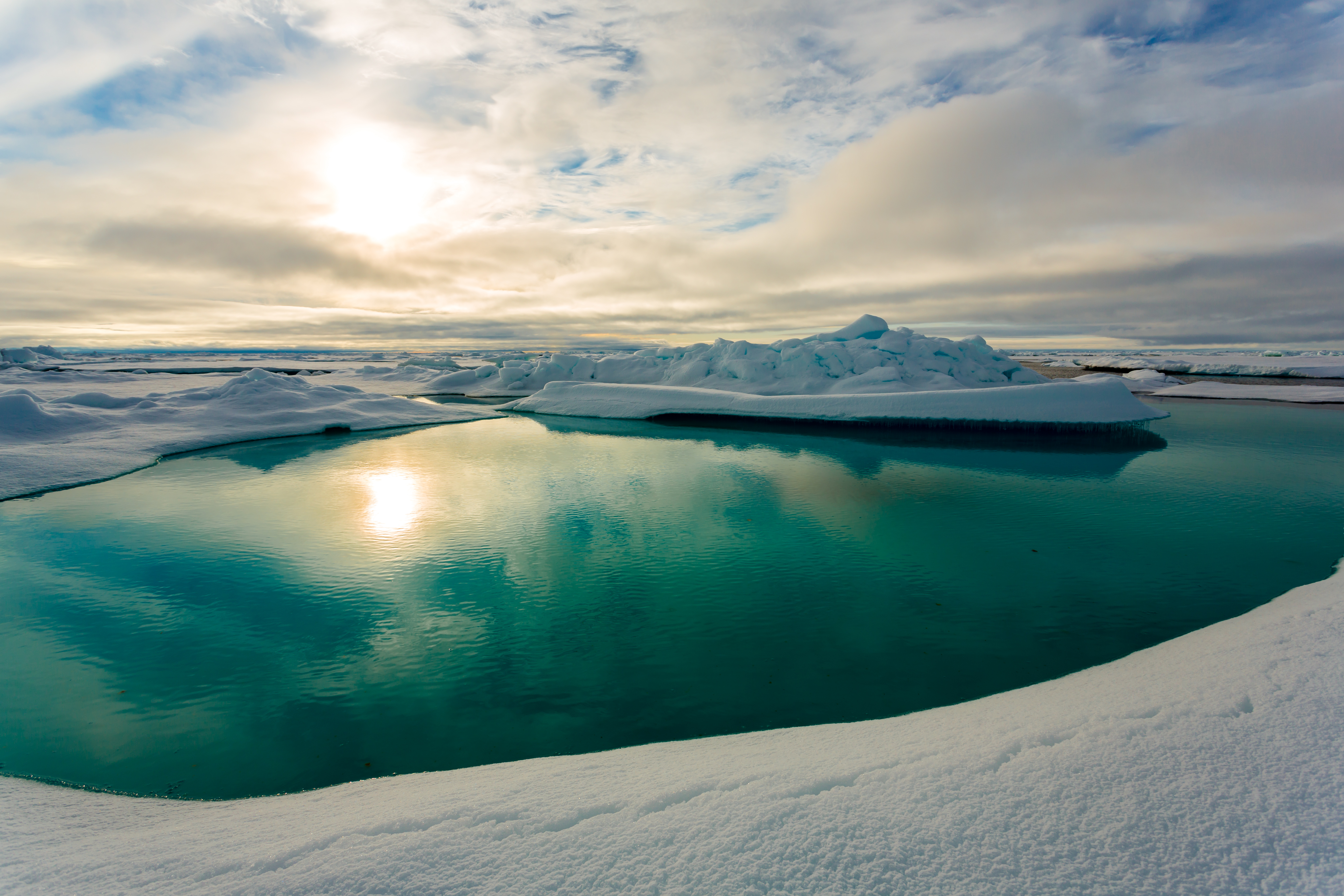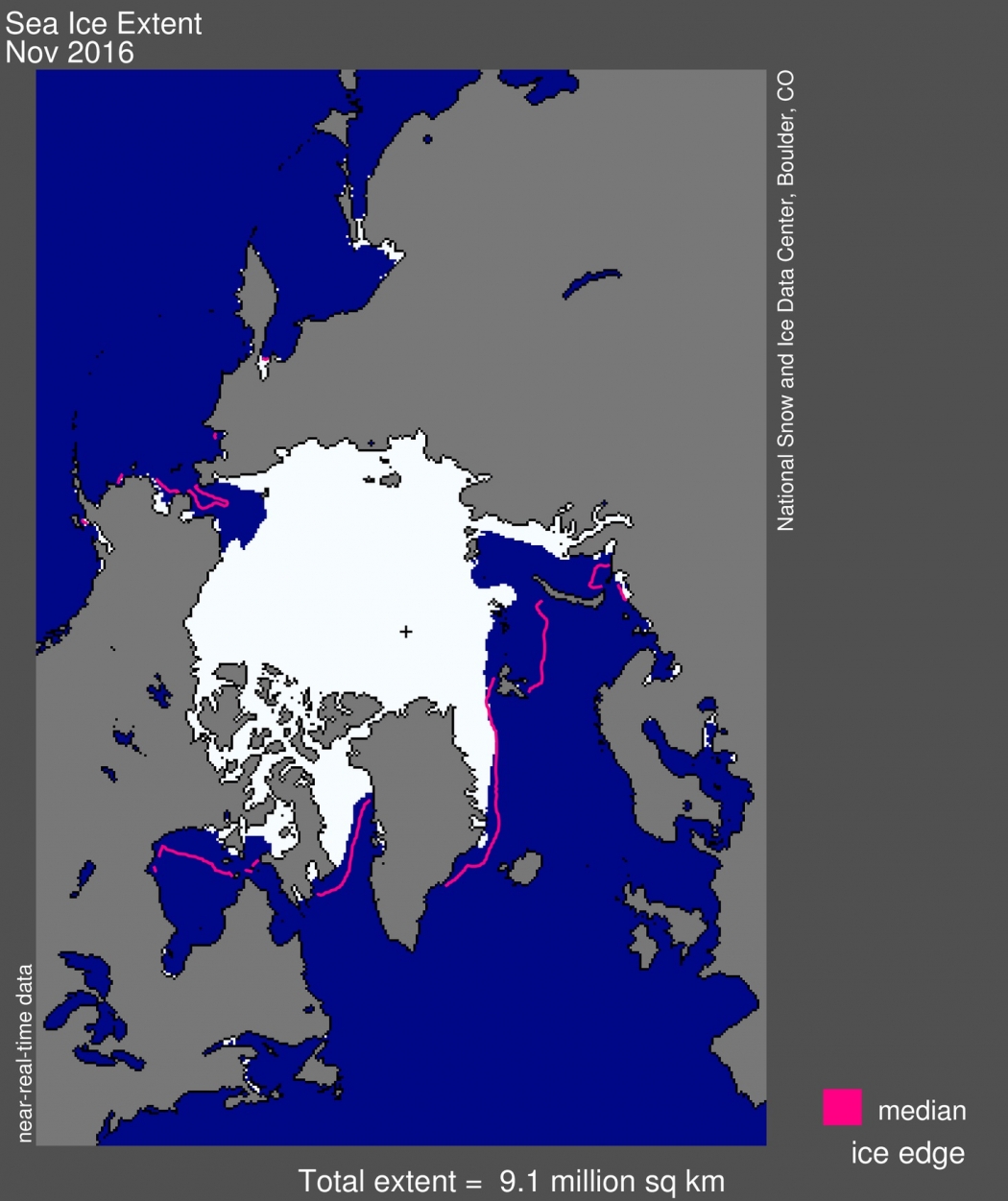Mexico-Size Chunk of Ice Missing from the Arctic

The Arctic is missing a chunk of sea ice the size of Mexico.
While fall ushers in the season of sea ice growth, November saw a brief retreat that was virtually unprecedented in nearly 40 years of satellite records, according to data released Tuesday by the National Snow and Ice Data Center. That dip helped November set a record low for sea ice area — the seventh month to do so this year, also a record.
At the opposite pole, the sea ice fringing Antarctica also set a record low for November, reversing several years of record highs, though what's driving the flip-flopping isn't clear.
"It is very striking this November in both hemispheres," NSIDC scientist Julienne Stroeve said in an email. "It certainly is continuing the long-term decline in Arctic sea ice. It's a bit more curious about what is happening in Antarctica, so more research on that is needed."
Unusual Cold Season Retreat
Arctic sea ice follows a seasonal cycle, waxing during the cold, dark months of fall and winter, and waning when the sun re-emerges in spring and summer.

But skyrocketing Arctic temperatures, which are rising twice as fast as the global average, have set off a downward spiral in sea ice levels. Summer has seen the biggest decline, with the end-of-season minimum half of what it was just three decades ago.
Sign up for the Live Science daily newsletter now
Get the world’s most fascinating discoveries delivered straight to your inbox.
A recent study found that emissions of carbon dioxide equivalent to that from a single transatlantic flight translates to a loss of 30 square feet of sea ice. If emissions aren't brought under control and temperatures continue to rise, the Arctic could become ice-free during summer by the middle of the century.
That loss of ice affects regional flora and fauna, native communities, and industrial activities like shipping. It may even exert an influence on weather patterns of North America, Europe and Asia.
The end-of-winter maximum this year hit a record low thanks to remarkably warm winter conditions in the Arctic, with air temperatures 4°F to 11°F (2°C to 6°C) above average. But relatively cool and cloudy summer weather kept the summer minimum from beating out the 2012 record low.
As the sun set for the winter, ice began to grow like usual, though it stayed well below normal week after week.
Then, in mid-November, an odd thing happened: the sea ice began to decline. Before it resumed its upward trajectory, sea ice area dropped by 19,300 square miles — a feat virtually unprecedented in the records. The only similar occurrence was a much smaller drop of 5,400 square miles in November 2013.
That unusual cold-season dip helped November finish with a sea ice area 753,000 square miles below the 1981 to 2010 long-term average for the month (even though the growth rate of sea ice was slightly higher than average), just a bit smaller than the area of Mexico.
Not a ‘Tipping Point'
The strange cold-season dip in sea ice extent was caused by persistent southerly winds pulling in warm air and warm ocean waters that kept sea ice from forming in the Barents Sea, an area north of Scandinavia and eastern Russia. Sea surface temperatures there were up to 7°F (4°C) above normal during November near Norway's Svalbard Peninsula.
"Typically sea ice begins to form in the fjords at the beginning of November, but this year there was no ice to be found," Stroeve, who was in Svalbard during the month, said in a statement.
Sea ice also dropped unusually sharply in Antarctica, which is nearing summer. The average November extent there was 699,000 square miles below the 1981 to 2010 average, more than twice previous record low for month. NSIDC scientists think the decline was due to warmer air temperatures and a rapid change in the air current that whips around the continent.
In previous years, Antarctic sea ice hit record highs, potentially due to changing ocean conditions linked to the melting of land-bound glaciers. But polar scientists say there is still much to learn about what drives the behavior of Antarctic sea ice, which is quite different than its Arctic cousin.
Stroeve and other sea ice researchers don't think this year's Arctic ice records mark a tipping point, or a point where such loss becomes irreversible. Scientists worried about reaching such a point-of-no-return when sea ice first plummeted to a record low in 2007, but it has since rebounded (though the long-term decline continues) and if warming is brought under control, sea ice can grow back.
"I still don't think we have a tipping point only because the ice could come back if we limit the warming — it's not irreversible," Stroeve said.
It is possible, though, that such a cold season retreat could become more common as global, and Arctic, temperatures, continue to rise.
"I think this is something we might expect to see more of in the future," Walt Meier, a NASA sea ice researcher, said. "With less ice in the summer and more warming of the ocean, there is more heat available near the ice that can be pushed (by winds) into the ice [and] at least temporarily melt back some ice early in the growth season."
You May Also Like: A Climate Denier is Leading the NASA Transition Warming U.S. Could See Extreme Rains Increase Fivefold U.S. Oil Exports Skyrocket Despite Climate Pacts Extreme Tornado Outbreaks Are Becoming More Extreme
Original article on Climate Central.

Andrea Thompson is an associate editor at Scientific American, where she covers sustainability, energy and the environment. Prior to that, she was a senior writer covering climate science at Climate Central and a reporter and editor at Live Science, where she primarily covered Earth science and the environment. She holds a graduate degree in science health and environmental reporting from New York University, as well as a bachelor of science and and masters of science in atmospheric chemistry from the Georgia Institute of Technology.









